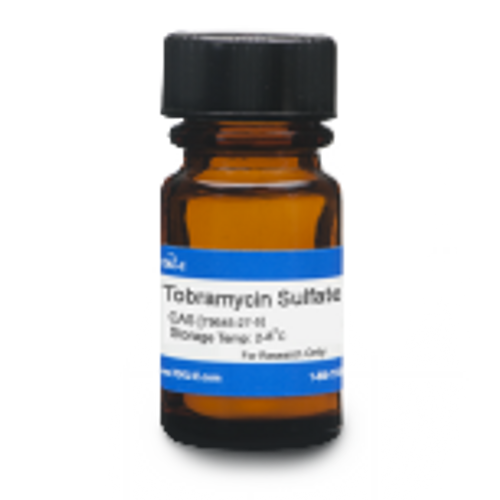TOKU-E
Research Antibiotics, Tobramycin Sulfate, 500mg
- Part Number:
- TOK-T010-500mg
- Lead Time:
- 2-3 days
- Shipping:
- FREE SHIPPING on most orders over $50*
- Quantity:
- each
- Size:
- 500 mg
- Style:
- chemical
Description
Tobramycin Sulfate, 500 mg.
Tobramycin sulfate is an aminoglycoside antibiotic derived from Streptomyces tenebrarius. Tobramycin is a member of a broad-spectrum antibiotic complex, nebramycin, that was originally isolated in 1967 by Eli Lilly and Company. The nebramycin complex was separated into various factors, with nebramycin factor 6 showing in-vitro activity of clinical usefulness. Nebramycin factor 6 was subsequently designated tobramycin.
Tobramycin sulfate is a bactericidal protein synthesis inhibitor, able to bind to the 16S rRNA of the 30S ribosomal subunit, inhibiting translocation, and eliciting miscoding of the proteins. Tobramycin Sulfate has also shown a disruptive effect on the outer membrane of gram-negative bacteria at high concentrations.
Tobramycin sulfate is active against gram-negative bacteria and is frequently used to eliminate Pseudomonas aeruginosa in cystic fibrosis patients. Tobramycin like other aminoglycosides can be used to treat gram positive bacterial infection, but other types of antibiotics are more potent and less toxic. Tobramycin shows activity against mycobacteria but is mostly ineffective against fungi and viruses.
Tobramycin is freely soluble in aqueous solution ≥50 mg/mL. Conforms to the United States Pharmacopeia specifications.
- Category: Microbiology
- CAS Number: 79645-27-5
- Molecular Formula: C18H37N5O9 • H2SO4
- Molecular Weight: 565.59 g/mol
- Mechanism of Action: Following active transport into the cell, tobramycin sulfate binds irreversibly to a specific aminoglycoside receptor on the bacterial 30S ribosomal subunit and interferes with the initiation complex between messenger RNA and the 30S subunit, thereby inhibiting initiation of protein synthesis, consequently leading to bacterial cell death. In addition, tobramycin induces misreading of the mRNA template causing incorrect amino acids to be incorporated into the growing polypeptide chain, consequently interfering with protein elongation.
- Storage Conditions: <30°C
- Tariff Code: 2941.90.1010
- Spectrum: Tobramycin sulfate USP is effective against aerobic, gram-negative bacteria, like Acinetobacter and Enterobacter, but is particularly effective against Pseudomonas aeruginosa bacterial strains. Infections caused by Gram-positive bacteria can also be treated with aminoglycosides, like tobramycin sulfate, but other types of antibiotics are more potent and less damaging to the host. In the past the aminoglycosides have been used in conjunction with penicillin-related antibiotics in streptococcal infections for their synergistic effects, particularly in endocarditis. Tobramycin is mostly ineffective against anaerobic bacteria, fungi, and viruses.
Microbiology Applications
Tobramycin is commonly used in clinical in vitro microbiological antimicrobial susceptibility tests (panels, discs, and MIC strips) against gram negative microbial isolates. Medical microbiologists use AST results to recommend antibiotic treatment options for infected patients. Representative MIC values include:
Pseudomonas aeruginosa 0.25 µg/mL - 16 µg/mL
It is used to treat pseudomonas aeruginosa lung infections and is used in combination with other antibiotics to treat urinary tract infections, gynecologic infections, endocarditis, pneumonia, sepsis, peritonitis, respiratory infections, osteomyelitis, and other soft-tissue infections. It is a potential therapy for sinus infections. Tobramycin is used in Antimicrobial resistance studies.
Plant Biology Applications
Tobramycin Sulfate can be used to eliminate Pseudomonas aeruginosa infections in plants, soil, and water.
Tobramycin has been used in conjunction with the aac(6')-Ie/aph(2")-Ia gene as an efficient selection system for the transformation of chloroplasts. The system's efficiency is comparable to the selection of transplastomic lines with spectinomycin resistance conferred by the resistance gene aadA. Importantly, no spontaneous antibiotic resistance mutants appeared under tobramycin selection.
Tabatabaei, I., Ruf, S., & Bock, R. (2016). A bifunctional aminoglycoside acetyltransferase/phosphotransferase conferring tobramycin resistance provides an efficient selectable marker for plastid transformation. Plant molecular biology, 93(3), 269-281.
Specifications
- Form: powder
- Appearance: white to off-white powder
- Source: Streptomyces Tenebraius
- Water Content (Karl Fischer): Not more than 2.0%
- pH: 6.0 - 8.0
- Assay (on dried basis): 634 - 739 µg/mg
- Loss on Drying: Not more than 0.5%
- Residue On Ignition: Not more than 1.0%
- Heavy Metals: Not more than 0.003%
References
Davis, Bernard D. "Mechanism of Bactericidal Action of Aminoglycosides. "Microbiological Reviews 51.3 (1987): 341-50.
Available Documents
Made by an ISO 9001:2015 certified antibiotic manufacturer focused on creating antibiotics through fermentation.
By removing contamination and streamlining gene selection, these research antibiotics help scientists make discoveries in cell/plant biology, microbiology, virology, stem cell therapy, and cancer research. Specializing in the pharmaceutical and biotech research sectors.
These products are specifically designed for research use and are not approved for human or animal consumption. Not FDA approved.
Note: These chemicals are for research & laboratory use only. Your order will not be processed if you do not ship to a registered laboratory or research facility.
Please note: This product is not returnable.

